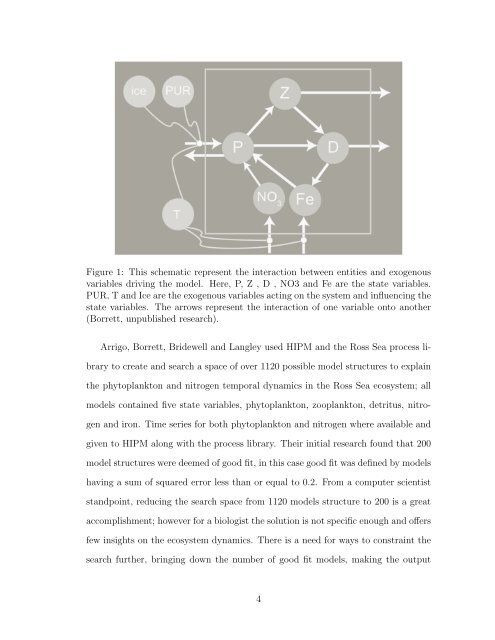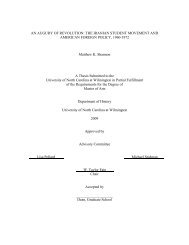HIERARCHAL INDUCTIVE PROCESS MODELING AND ANALYSIS ...
HIERARCHAL INDUCTIVE PROCESS MODELING AND ANALYSIS ...
HIERARCHAL INDUCTIVE PROCESS MODELING AND ANALYSIS ...
You also want an ePaper? Increase the reach of your titles
YUMPU automatically turns print PDFs into web optimized ePapers that Google loves.
Figure 1: This schematic represent the interaction between entities and exogenous<br />
variables driving the model. Here, P, Z , D , NO3 and Fe are the state variables.<br />
PUR, T and Ice are the exogenous variables acting on the system and influencing the<br />
state variables. The arrows represent the interaction of one variable onto another<br />
(Borrett, unpublished research).<br />
Arrigo, Borrett, Bridewell and Langley used HIPM and the Ross Sea process library<br />
to create and search a space of over 1120 possible model structures to explain<br />
the phytoplankton and nitrogen temporal dynamics in the Ross Sea ecosystem; all<br />
models contained five state variables, phytoplankton, zooplankton, detritus, nitrogen<br />
and iron. Time series for both phytoplankton and nitrogen where available and<br />
given to HIPM along with the process library. Their initial research found that 200<br />
model structures were deemed of good fit, in this case good fit was defined by models<br />
having a sum of squared error less than or equal to 0.2. From a computer scientist<br />
standpoint, reducing the search space from 1120 models structure to 200 is a great<br />
accomplishment; however for a biologist the solution is not specific enough and offers<br />
few insights on the ecosystem dynamics. There is a need for ways to constraint the<br />
search further, bringing down the number of good fit models, making the output<br />
4
















